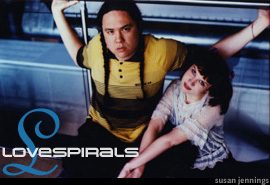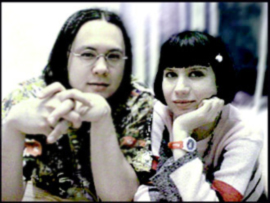May 2002, Jive Magazine, Russ Marshalek
Q: When did the Ryan/Anji collaborations begin, and how did that come to be? Is it a 50/50 sort of artistic collaboration, with one person writing music and the other writing vocals?
Anji: Ryan and I started working together late 1998, early 1999. We pretty much hooked up through my radio show on KUCI 88.9fm (in Irvine, CA). He had me come over to his studio to check out some new stuff he was working on (which later turned out to be ‘Beatitude’ and ‘Love Survives’) and I was really into it. The first two songs we did, “Ecstatic” and “Hand in Hand,’ Ryan made dub plates of; he was more heavily into deejaying at that time.
We actually write the songs together. There’s no one way we compose, exactly, but lately we’ve been working from guitar and vocal lines first. I go around singing things all the time, so I’ve got a backlog of song ideas to work on whenever he’s ready. Ryan plays guitar and bass, and can hack out stuff on keyboard, so he does all of that for us. He does most of the programming, too, I pretty much just co-write and produce along side of him. I don’t really play any instruments, but I’m into sampling and looping, and know my way around ProTools and Peak, which is what we basically use.
Writing music is a really interesting, complex thing ‘ it’s difficult to describe the process of give and take that goes into it.
Q: How did you come to be such a fan of LTJ Bukem and Good Looking records?
Ryan: It started when I first heard LTJ Bukem’s Logical Progression: Level 1. Disc 1 was amazing, but when I finally got around to disc 2, my world had been majorly rocked. There’s some amazing songs on there, like the opening Funky Technicians song, and Photek’s remix of ‘Pharaoh’, and Seba’s ‘So Long’ which was my favorite song is the world for quite a few years.
I’ve seen a few of the Good Looking crew DJ out here. Of course, Bukem has been out many times at big events, but I was lucky enough to see some Seba and PFM DJ’ing at some very intimate clubs. PFM played several dub plates of some of the most amazing unreleased stuff I’ve ever heard, with samples from old blues and jazz recordings thrown in.
Q: Ryan, I’ve read that you DJ out at clubs regularly. Is this still the case? What genres of music do you tend to play most, and why?
Ryan: I haven’t DJ’d out for quite a while now, perhaps a year. There are many reasons why, but it’s mainly because I wanted to focus all my time into recording and completing my album. Prioritizing is important and completing the album was my highest priority. DJ’ing would have taken away from my music making time.
When I began, I was playing a lot of atmospheric and jazzy drum and bass. Over time, my sets had less and less drum and bass and more down tempo. The last bunch of records I just bought on a recent trip to San Francisco was all jazzy deep house, which I’ve become more fond of lately. Jazz step seems to have kinda died while jazz lives on strong in deep house. I’m not prejudiced to any kind of beat or genre. As long as the music is moving, I’m there.
Anji: One of the last gigs Ryan did was a sunrise set for the chill-out room of a smaller rave event. Not sure if anyone would have him out to a huge rave, but if they had a chill area, I’m sure he could pull it off just fine. We’ve been talking about maybe working up a tag-team set, because we both love collecting music and I’ve bought at least half of the most recent 12’s. I’ve always wanted to try MC’ing a little bit to his sets, so that’s another option we might follow up on sometime.
Q: Do you find yourselves fans of other genres of dance music outside of the jazz-step area? If so, what? Any particular DJs or producers you’re fans of or interested in?
Ryan: As I mentioned, we’re interested in Deep House, and we know many DJ’s and producers of House. Our sax player, Doron, is on Subliminal Records, a well known NY house label. His band, Monkey Bars, is about to take off with some very catchy vocal house songs. We also like down tempo; anything that’s got a soulful groove really.
Anji: I really love a lot of the producers on OM, and Naked Music has some nice stuff coming out, too. I tend to be more vocal based in my interests than Ryan, and sometimes I like stuff a little harder or more experimental than he does. I listen to a lot of electronica of different genres, but he’s a little pickier. My current favorite is definitely Soulstice. I think we have a lot in common with them, musically. I dig really poppy stuff like Everything But the Girl, Sade, Olive, Lamb, Mandalay, Halou ‘ I could go on and on with that list!
Q: Where do you stand on the issue of electronic song downloading via sources such as, MP3.com, and all the Napster clones that have risen up?
Ryan: I think legal mp3s and streaming audio are great ways to get more people aware of you and your music. The bad side is that there’s people who may never buy your record, and instead, spend hours and days searching for illegal mp3s. Digital music on the Internet a two-edged sword for sure.
Anji: I’m a total Internet music junky! There are a number of sites I frequent with perfectly legal mp3s, and those are really a blessing to me. I have definitely gone out and bought albums from bands that I found out about through mp3s! In fact, most of the albums I’ve picked up over the past 2 years have been ones that I fell in love with through mp3s first. I’d like the think that the same could be happening for us.
Q: Your upcoming album actually moves AWAY from the ambient drum and bass sound, and back towards older, more Love Spirals Downwards sounding music. Was this a conscious move? Where do you see the Lovespirals sound going after this album?
Anji: We enjoyed creating Windblown Kiss very much, and we really poured a lot of ourselves into it, but at the same time, we were sorta thinking of Projekt Records when we were working on it. Not the whole time, obviously, but at some point in the process we made certain choices to tailor the song list towards acoustic based material and away from dance tracks. There are other songs we recorded during this same time period, like ‘Love Survives,’ that we chose not to include on this album.
When we sent Projekt the Ecstatic EP, their advice was to ‘cut out all the crazy drums’ and then they’d be into it. I was like, ‘this is break beat music, it’s BASED on the drums, man!’ Windblown Kiss is more their cup of tea. We’ve kept the new Jazz elements Ryan had been working with, and then supplemented that with nice atmosphere, dreamy guitar, and soulful, yet ethereal vocals. It’s all very relaxing and sensual, as you might expect, its just a bit more organic than anything we’ve done together before. We have every intention of producing an album of more dance-based material next, though.
We’ve released a few songs on Water Music Records comps, and a few other things are coming out with some of our electronic stuff here and there, so hopefully we’ll catch the attention of the right label eventually.
Q: Where do you see yourselves, musically and/or personally, in ten years?
Ryan: That’s too hard to say; one never knows what life has in store for you. I’ll keep working hard, doing what I love, and that should mean that I’ll be making some great music still in 10 years.
Excerpt from the full interview at Jive Magazine.


